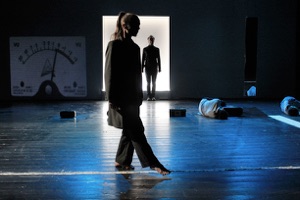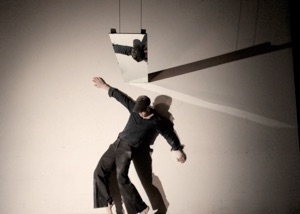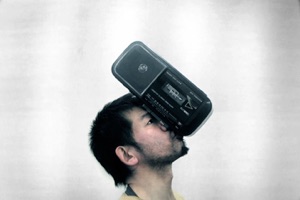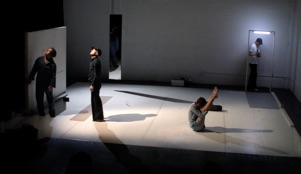An interdisciplinary project presenting a series of performances and images reflecting on silences found in cities and everyday objects of orientation. With resonate inquiries to visualization, absence, and materiality, the work unfolds a series of precarious architectural scenes. The setting of the scene(seen) marks an area of the unseen(unscene). As a discursive construction, cross-references span the disparate environments of the works making in Tokyo, Taipei, Berlin, and San Francisco.
Made of Silence, Air, and Glass
Made of silence, air, and glass collects from three different works initiated outside of the US beginning in 2010: Stations of Appearance (a site-specific work for photography and video created along the Tokaido Railway Line between Tokyo and Kyoto in connection with the Japan-US Friendship Commission), in 2011: At the Window (inspired by a man in his eighties with Alzheimer's who repeatedly opened the windows of local residents questioning why they were there and who invited them - created while in residence at the Treasure Hill Artist Village in Taipei), and Different Types of Silence (a dance performance for theater exploring oppositional notions of silence in primary collaboration with Yuko Kaseki and Diego Agullo - created in Berlin at DOCK 11, ADA, and F40/Theatre Thikwa). These works were re-developed in connection with new layers created in San Francisco (while in residence at TheOffCenter) for a presentation at CounterPULSE (April 6-8, 2012).
For the San Francisco production, the work enlists an idiosyncratic cast of notable collaborators, Yuko Kaseki (Berlin based contemporary Butoh dancer and movement artist, and co-founder of cokaseki), José Navarrete (San Francisco based choreographer and performance artist, and co-founder of Navarrete x Kajiyama Dance Company), and Christian Nagler (San Francisco based artist, writer, translator, and performer, often creating as part of the Nonsite Collective).
photographs: Tableau Stations / Isak Immanuel




dance / performance:
Yuko Kaseki, José Navarrete, Christian Nagler, Isak Immanuel
artistic direction / photography and video installation:
Isak Immanuel
+ added guests for video



As artistic director and initiator, the decisive moment to pursue this as a work came from the shift in silence I experienced when witnessing a young man on a bicycle crashing into the side of a turning car going full speed at one o’clock in the morning in downtown Los Angeles. The streets where mostly empty, as I was waiting in another silence for a late night bus to arrive. Later that week, I was to take part in a ten-day silent meditation. After that I was to leave the United States for Europe, thinking I may not return, wishing to leave behind me, cities and a country, to which I had grown mute. Now, my aim here is to create a choreographic work exploring and expanding a catalog of silences as they relate to communication, landscape, privacy, power, and direct body resonance.
As a point of entry, I reference the above individual experiences (and not fully transparent feelings, another kind of silence) as initiators to approach the difficulties and complex layerings of silence that can be found in a number of personal and social situations.
In part, the aim is to look at the space that connects silence to a diverse range of ideas and experiences such as uniforms, mauna (the religious observation of silence), a glance, the moon, mirrors, shame culture, solitude, insects, or an automotive accident.
It leads me to a question of what initiates or governs movement relative to an idea of dance, listening, and witness.
different types of silence / Berlin 2011 (Isak Immanuel)
further:
A land’s silences, by the station / San Francisco 2012 (Isak Immanuel)

Commonly, the more one moves away from a sense of a homeland, the greater the specificity and trace of this absence nags as an unattended inquiry. In contrast to being outside of the United States for much of the formation of this work, and in connection to a mixed-nation ensemble, a book evocatively titled “American Silences” (by Joseph Anthony Ward), featuring the painter Edward Hopper has given this work an added inquiry of the relationship of silence to nationalism, geography and a sense of place. Each nation, and within that, each person holds a different type of silence and listening space; Hopper's scenes of wordless social situations and the (dis)quieted architecture of a Depression era to mid-20th century American landscape hold one resonance and question.
The Art Historian Robert Hughes once remarked of Hopper, "(he) saw that the old frontier had moved inward and now lay within the self, so that the man of action, extroverted and self-naming, was replaced by the solitary watcher." With his insistence of non-action, Hopper is almost an impossibility for a dance reference, but it is in this space of approaching paradoxical bodies that the work Made of silence, air, and glass looks to map a disparate kinetic and visual space. It is a place where materials and bodies are employed in movement and successive stillnesses without a settled sense of equation. Decisively distinct from Hopper, the work unfolds in an assemblage vernacular, mapping a distance to a singular medium and a solely American landscape. Here, in the unease of borderlines and ambiguous places marked by different types of silence, the internationally composed cast shifts through restless questions of human connection, architecture, and context for a body.
As key thematic ingredients, silence, air, and glass, are placed discursively with fragments of common building supplies such as bricks and wood; while plastic and metal tape players take the role of everyday company or a spokesperson to/for a silent body.
Overall, the work enacts a collage sensibility, pieced together from many things, kinetic with some noise on the edges, questioning identity, lacking resolution.
Engaged with inquiries to a silent self within inoperative communities and groups, the work unfolds as a labor for perception, memory and communication. It is made of many things, at the edges, searching for what materials will confide.
part of the process: >
―
"How do you know what an empty room looks like, if no one is there?"
(Edward Hopper, interview on painting)
“"What I think, or what I say, or to whom to speak, it doesn’t matter to them. They are only interested in how strong my voice vibrates the air. For them, air is vibrating, that is why I exist."
(The Kangaroo Communique, by Haruki Murakami)
“Silent friend of many distances, feel
how your breath enlarges all of space.
...And if the earthly no longer knows your name,
whisper to the silent earth: I'm flowing.
To the flashing water say: I am.”
(excerpt from the Sonnets to Orpheus, by Rainer Maria Rilke)
"Silence is the only voice of our God."
(Pierre: or, The Ambiguities, by Herman Melville)

―
TABLEAU STATIONS
|
Isak Immanuel
INTERDISCIPLINARY DANCE PERFORMANCE

works:















